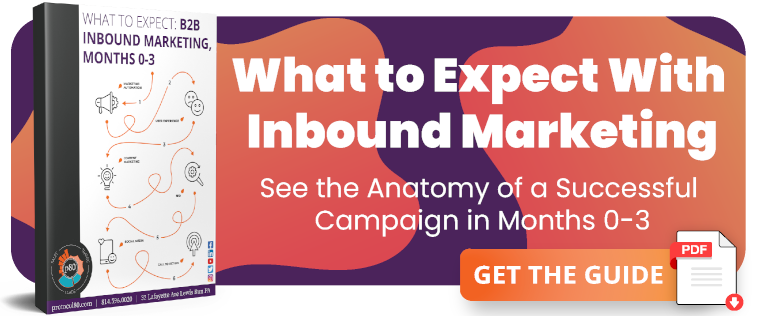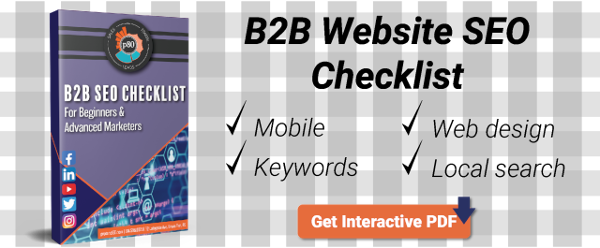Inbound Marketing Blog
for Manufacturers and Healthcare Companies
B2B Digital Marketing Plan Templates for 2024: KPIs & Goal Setting

In digital inbound/content marketing, we say, “Work SMARTer, not harder.”
Why all the caps? Because any data-backed, results-oriented marketing strategy has its roots in SMART goals. We define SMART goals as digital marketing KPIs (key performance indicators) and benchmarks that are:
- Specific
- Measurable
- Attainable
- Relevant
- Time-bound
Why is SMART goal setting and content planning important to inbound marketing? It ensures everyone involved understands the who, what, when, where, and how (and even why) of your growing your business through digital marketing.
Fortunately, this post includes two free B2B marketing plan templates (click them to jump ahead to them):
(Wanna take it with you? Get a PDF content plan template here.)
Use these SMART marketing goals templates to make more efficient use of your budget and stay on track toward meeting your KPIs (key performance indicators).
TEMPLATE #1: B2B Marketing Annual Goal-Setting
Learning how to set great digital marketing goals and metrics is a lesson in patience and persistence.
Remember, your marketing goals should be:
- Specific: “Increase new and return customers by 10% each” rather than “Get more customers”
- Measurable: Know what’s working and not working, and improve the next time around
- Attainable: Set realistic expectations for stakeholders and avoid overburdening staff
- Relevant: Make strategies that match and help attain big-picture company goals
- Time-bound: “Grow X% within 6 months, with exec team check-ins every 2 months” rather than “Achieve this ... soon?”
All stakeholders should sign off on these goals so everyone’s aligned and there are no surprises.
OK, onto the template. For our example, let’s pretend to be a company that offers B2B packaging solutions:
Questions – Business Goals
1. What were the company’s biggest challenges in 2023?
- This is where you’ll identify issues that inbound marketing could help solve.
- You also may learn where current marketing efforts aren’t making an impact.
- Example: “The inability to forecast anything – lead times, supplies, etc. – due to world events outside our control was challenging.”
- Example: “We didn't realize a positive ROI for our trade shows again this year."
- Example: “We were blindsided by the sudden takeover of AI technology, and had to spent a lot of time educating ourselves."
- Example: “We now rely on remote selling tactics as our primary avenue, and we still aren’t fully equipped/prepared.”
2. What happened that got the company excited in 2023?
- This is where you’ll learn from executives and the sales team what “really mattered” in the end. What drove the most meaningful sales conversations and the biggest deals? What can you repeat in the coming year?
- Example: “We tried a more organized, comprehensive approach to our trade show marketing, engaging leads before, during, and after the show. We were able to more easily collect lead information and have conversations lined up before we even arrived!”
- Example: "We got serious about inbound marketing and saw a huge impact on our sales pipeline. We plan to continue and expand these efforts this year"
3. Is the company shifting focus to a particular product/service, industry, or persona this year?
- Learn where the leaders hope to take the company in the coming year. Your marketing content topics should support that.
- Example: “We’re hiring operators so we can do more laser etching and engraving – we should probably write something about that topic.”
- Example: “Sustainability has become a huge push in our industry, so we want to present ourselves as environmentally friendly to those types of people.”
4. Any word on trade shows or other event attendance?
- Jot down a list of events your company will attend either in-person or virtually. What kind of content can you create that’ll engage leads before, during, and after the event?
- Example: “We’re attending FABTECH 2024 in October. Before the show, we could share educational articles on social media using the show’s official hashtag. We could also email leads from last year’s event and invite them to reconnect.”

Questions – B2B Content Marketing Goals
5. What content seems to perform best when talking with leads/customers?
- Ask the sales team what content is helping leads become customers, and customers become happy customers. Make more of that.
- Example: “Ink transfer -- these leads tend to be more responsive and open to a new way of doing things.”
6. Any info that’s not currently on the website, but should be?
- Does your website clearly show what makes you different and/or better than your competitors?
- Are your newest products and services on the website?
- Example: “A lot of customers end up needing help diagnosing their printing issues. Can we make an embedded tool where they can self-diagnose and come more prepared to their first conversation with us?”
- Example: “We recently earned a new ISO certification – let’s get that on the site.”
Questions – Sales
7. What new customers came in that everyone got excited about?
- Learn what business types, verticals, products, etc. are driving the business that makes stakeholders and the sales team sing. These areas may be where you’ll want to focus marketing efforts for additional gains in 2024!
- Example: "We now serve an additional location of a pre-existing customer. The new business is due to more people mailing products these days.”
- Example: “We helped a customer add a new product line by embossing onto film for lenses on glasses.”
8. Where does the sales team lose time doing the same things repeatedly?
- You can identify opportunities for sales and marketing automation to free your teams up to handle other tasks.
- There may also be content and forms you can create or edit to provide more insight for the sales team.
- Example: “Can we create sales email templates and automated sequences for certain repeat situations?”
- Example: “We keep having to ask the same questions of customers who omit important details on their RFQ. Can we replace some of the RFQ form’s fields with more useful ones?”
Questions – Team
Are we missing out on marketing opportunities due to a lack of support?
- Examine whether you’re struggling to reach goals because your staff lacks the time to get the work done consistently.
- Example: “Barb said she’d write two blog posts per month, but she only finished 11 in all of 2023. Can we shift this responsibility to Todd, who has more availability and likes writing?”
Are the right people leading our strategy/content?
- Examine whether your staff is capable of executing a content plan that actually works.
- Example: “Our website isn’t ranking in Google, but we lack the skills and knowledge to improve the situation. Let’s look into hiring an outside SEO/PPC firm.”
Now, Make Your Goals
After answering the above, you should be able to set goals for email marketing, social media marketing, blogging, etc. Based on your current metrics in each area of your B2B marketing, set specific numbers you’d like to increase your KPIs by.
For each SMART marketing goal, ask yourself:
- How many hours per week can your team dedicate to inbound marketing?
- Is this goal realistically attainable in your desired time frame?
- What’s the biggest marketing challenge keeping you from hitting goals?
- What are three steps you can take to mitigate that obstacle?
TEMPLATE #2: Create an Annual Digital Marketing Plan
Once you have mutually agreed-upon goals in place, you can research how to meet them.
Your plan depends on not just the goals you set above, but also the 2023 performance of the main KPIs in your digital marketing efforts. Examples of B2B digital marketing KPIs and clues for future content include:
How to Set Marketing KPI Metrics & Next Steps
Overall Website Traffic
- How did web traffic KPIs compare to the previous year's?
- How much of the traffic came from paid ads?
- What’s the average time a user spends on your important pages? (Are visitors leaving in < 1 minute because they’re not finding what they’re looking for?)
- What’s the bounce rate for your high-traffic pages? (Are visitors leaving your site after their first page visit because they see no value in or prompt to visit other pages?)
Blog Views
- Was there growth from last year?
- What % of your total website traffic arrives via the blog?
- How much came from social media?
- How much came from email marketing?
- Are there certain topics that perform especially well?
- Are there certain forms of content that perform especially well (i.e. how-tos, solution comparisons)?
Conversions
- Was there growth in total and/or % of lead conversions from last year?
- Do certain blog/video topics drive a higher conversion rate?
- Do certain content types drive conversions unusually well (i.e. how-tos, solution comparisons)?
- Are certain types of offers (i.e. e-books, technical papers, consultations) more likely to convert leads?
Keyword/SEO Performance
(p80 Tip: SEO = search engine optimization, and is key to inbound marketing ROI.)
- What highly relevant keywords are you ranking on page 1 of Google for?
- What high-value keywords are you ranking on pages 2-3 for, and could reach page 1 for with further optimization?
- Has a once-successful blog post fallen off page 1 for an important keyword, and needs reoptimizing?
- Have you had success with certain keywords/topics that merit follow-up with a new, related blog post?
- Has your latest SEO audit shown significant issues (i.e. slow loading speeds, high number of broken links)?
PPC (Pay-Per-Click) Advertising
- Did PPC provide a suitable ROI for traffic?
- Did PPC provide a suitable ROI for lead conversions?
- Are there more relevant keywords or target groups that might bring better ROI?
- Has organic (nonpaid) traffic reached a level of success and stability that could allow you to reduce or end PPC reliance?
Email Marketing
- Was there growth in subscribers from last year?
- Was there improvement in open from last year?
- Was there improvement in click-through rate from last year?
- Which topics/formats of content get the most opens?
- Which topics/formats of content get the most click-throughs?
Social Media
- Was there growth in page followers from last year?
- Was there improvement in engagement (i.e. likes, shares) from last year?
- Was there improvement in clicks from last year?
- Which topics/formats of content get the most engagement?
- Which topics/formats of content get the most clicks?
- Which social platforms seem to bring the most value to your business?
- Based on the above, should focus shift to or away from a certain platform?
Video Marketing
- Was there growth in YouTube (or wherever you post videos) views?
- Are calls-to-action providing next-steps opportunities for viewers? How are their success rates?
- Are you missing any core content visitors expect (i.e. About Us, facility tour, product/service demo)?
- Can videos be added to related blog posts, landing pages, or testimonials/case studies?
Annual Content Marketing Plan Example
This is where you lay it all out for your stakeholders. Just be sure to place a big, ol’ asterisk next to your plan, along with a friendly reminder that analysis and business shifts may cause plans to change. However, you should also ask decision-makers to stay patient and avoid frequent one-off requests or strategy shifts that’ll delay you from meeting business goals.
In your plan, give a baseline for:
- How much content?
- When?
- By who?
- What’s the goal of each piece? (Don’t make stuff just to meet a quota.)
This time, we’ll use a metal components manufacturer as our example company:
WEBSITE
- Update website's Our Team page
- Add new, industry-specific subpages under Industries Served main page
CONTENT – BLOGGING
- Publish 3 new blogs a month
- Reoptimize 2 old blogs per quarter
- Submit 2 content pieces per quarter to Powder Metallurgy Review, specific to our new material for motor customers
CONTENT – PREMIUM
- Design 2 new e-books this year, focusing on the materials that are our unique selling points
CONTENT -- VIDEO/PHOTO
-
Film, publish, & promote a “manufacturing line demo”
-
Create GIFs for social media sharing
-
Capture new images (at least 25 usable) for blog and social media posts
CONTENT – EMAIL
- Stick to 1 per month newsletter sent
- Separate lists as much as possible based on content previously seen, and keep a general list too
CONTENT – SOCIAL
- Amp up visual content on social media (see above)
SALES SUPPORT
- Use AI and/or automation to fine-tune email strings to those who downloaded e-books
- Create automated follow-up emails for old, unengaged leads
- Continue HubSpot CRM training
Then, Create a Quarterly Content Plan
Yes, this article is about planning for a year’s worth of marketing, but hold your horses 🐎. You’ll want to make a road map for the next 3 months only. Planning out every little activity for an entire year will only waste your time once plans inevitably change (and change again).
p80 Resource: 3-Month B2B Content Mapping Template (w/ Example!)
Your content calendar, of course, will depend on the amount of time and people you’re still to invest in inbound marketing. Just as one example, in a given quarter you might execute:
| 12 new blog posts | 3 new product pages |
| 6 reoptimizations of old blog posts | 1 premium offer (i.e. e-book or whitepaper) – copywriting, design, & promotion |
| 75 social media posts – 10 each on LinkedIn & Twitter; 5 on Facebook) | 1 video and product photo shoot |
| 3 email newsletters | Monthly reports and weekly check-in meetings |
Is your ideal buyer never on Facebook or Twitter? Put your effort elsewhere. Do they strongly prefer case studies and whitepapers backed by data? Pour more time into those and reduce your blogging output.
In other words: Give your favorite buyer types what they want!
More Resources for Creating B2B Marketing Strategies
We hope you use these templates to their fullest! Inbound marketing – or any kind of marketing – only works when you make specific, data-driven plans that also account for your buyer persona.
To learn more about creating a B2B digital marketing campaign that gets you ranking in Google, add this free SEO checklist to your tool kit:
(Editor's note: This article was originally published in January 2022 and was recently updated.)
Our Blogs, Direct to Your Inbox!
How to Audit your Online Marketing
If you are executing digital marketing, congratulations! You are most likely already one step ahead of your competition, and making strides to meaningfully connect with prospects online. But, how do you know if you’re seeing continual success year over year, and improving your metrics?
Without the tools in place to analyze and benchmark your efforts, it is impossible to scale your online marketing and ensure continuous success.




